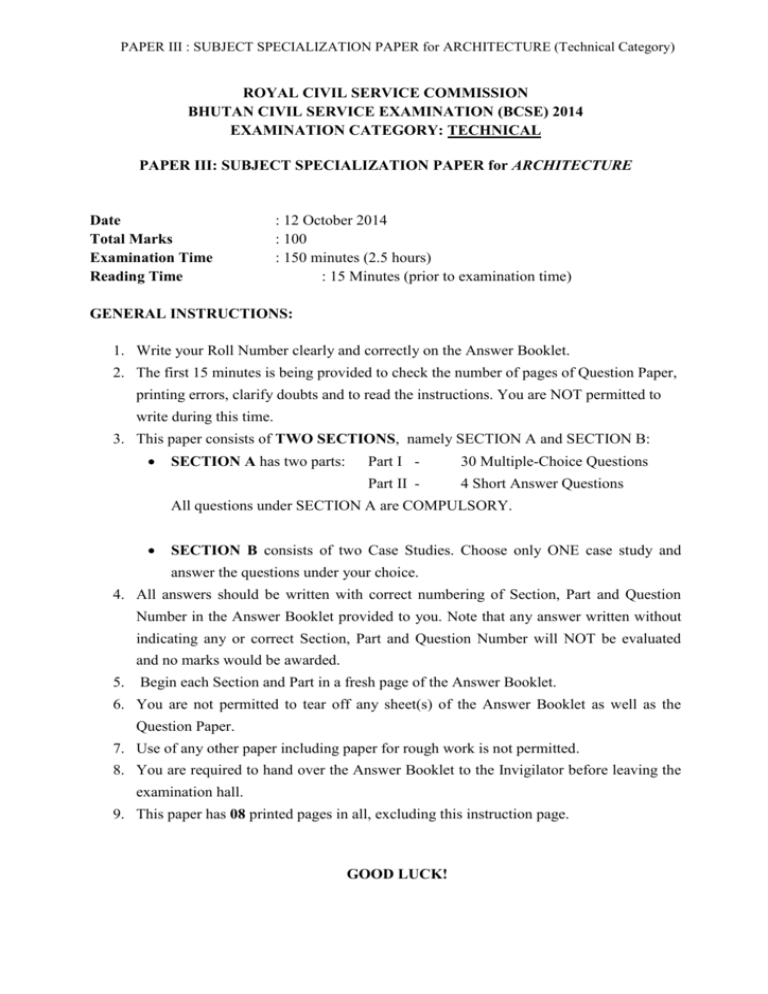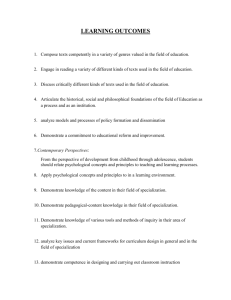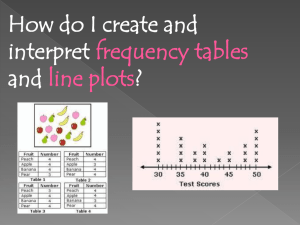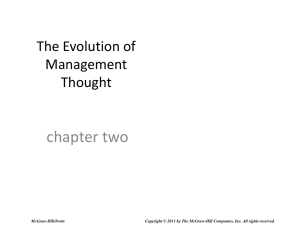Technical Paper III
advertisement

PAPER III : SUBJECT SPECIALIZATION PAPER for ARCHITECTURE (Technical Category) ROYAL CIVIL SERVICE COMMISSION BHUTAN CIVIL SERVICE EXAMINATION (BCSE) 2014 EXAMINATION CATEGORY: TECHNICAL PAPER III: SUBJECT SPECIALIZATION PAPER for ARCHITECTURE Date Total Marks Examination Time Reading Time : 12 October 2014 : 100 : 150 minutes (2.5 hours) : 15 Minutes (prior to examination time) GENERAL INSTRUCTIONS: 1. Write your Roll Number clearly and correctly on the Answer Booklet. 2. The first 15 minutes is being provided to check the number of pages of Question Paper, printing errors, clarify doubts and to read the instructions. You are NOT permitted to write during this time. 3. This paper consists of TWO SECTIONS, namely SECTION A and SECTION B: SECTION A has two parts: Part I - 30 Multiple-Choice Questions Part II - 4 Short Answer Questions All questions under SECTION A are COMPULSORY. SECTION B consists of two Case Studies. Choose only ONE case study and answer the questions under your choice. 4. All answers should be written with correct numbering of Section, Part and Question Number in the Answer Booklet provided to you. Note that any answer written without indicating any or correct Section, Part and Question Number will NOT be evaluated and no marks would be awarded. 5. Begin each Section and Part in a fresh page of the Answer Booklet. 6. You are not permitted to tear off any sheet(s) of the Answer Booklet as well as the Question Paper. 7. Use of any other paper including paper for rough work is not permitted. 8. You are required to hand over the Answer Booklet to the Invigilator before leaving the examination hall. 9. This paper has 08 printed pages in all, excluding this instruction page. GOOD LUCK! PAPER III : SUBJECT SPECIALIZATION PAPER for ARCHITECTURE (Technical Category) SECTION A PART I - Multiple Choice Questions (30 Marks) Choose the correct answer and write down the letter of the correct answer chosen in the Answer Booklet against the question number. E.g. 31 (c). Each question carries ONE mark. Any double writing, smudgy answers or writing more than one choice shall not be evaluated. 1. Greek architecture was essentially. a) Helm Roof b) Domical roof construction c) Columnar trabeated d) Arch and vault 2. Which historic style of architecture first introduced the clerestory? a) West Asiatic b) Roman c) Greek d) Egyptian 3. Buddhist architecture shown in rock-cut temples with lavishly carved interiors is a characteristic feature of what style of architecture? a) Roman b) Chinese c) Japanese d) Indian 4. Triangular piece of wall above the entablature. a) Pediment b) Pendentive c) Architrave d) Frieze 5. From the Greek temples, a temple that have porticoes of columns at the front and rear. a) Amphi-Prostyle b) Astylar c) Dipteral d) Tympanum Page 1 of 8 PAPER III : SUBJECT SPECIALIZATION PAPER for ARCHITECTURE (Technical Category) 6. "Form follows function". a) Le Corbusier b) Buckminster Fuller c) Louis Sullivan d) Marcel Lajos Breuer 7. Mies van der Rohe first envisioned the all-glass skyscraper in the 1920s.A true genius, he designed a structure that could not be built at that time, but some thirty years later the technology was at hand. The long-held dream of the crystalline tower was finally realized in these famous building, 38 stories of black steel and glass. a) Lakeshore Drive Apartment b) S.R. Crown Hall c) Seagram Building d) Lever House 8. "cubicula" or bedroom is from what architecture. a) Byzantine b) Roman c) Greek d) Egyptian 9. What do you call the tool in architecture which organizes space or spatial composition related to function? a) Space planning b) Functional interrelationship diagram c) Territoriality d) Space articulation 10. "Architecture is Organic". a) Frank Lloyd Wright b) Mies van de Rohe c) Le Corbusier d) Walter Gropius Page 2 of 8 PAPER III : SUBJECT SPECIALIZATION PAPER for ARCHITECTURE (Technical Category) 11. "A house is a machine to live in". a) Mies van de Rohe b) Le Corbusier c) Walter Gropius d) Frank Loyd Wright 12. Which construction system permit great spans of infinite variety of shapes of concrete, or steel combined with glass or plastic? a) Thin shell construction b) Frame construction c) Space frame d) Suspension system 13. What art principle shows the relationships between the various parts of an object/ structure/groups of objects and structures? a) Scale b) Proportion c) Size d) Volume 14. What is referred to as written record of man’s effort to build beautifully? a) History of architecture b) Pre-historic architecture c) Elements of architecture d) Style of architecture 15. Parts of an entablature, in order of top to bottom. i. Cornice ii. Frieze a) iii, i, ii b) i, ii, iii c) i, iii, ii d) ii, i, iii 16. The correct order of the following elements from top to bottom is: a) Choetseg, Pedma, Norbu Bagam and Dung. b) Pedma, Choetseg, Norbu Bagam and Dung Page 3 of 8 iii. Architrave PAPER III : SUBJECT SPECIALIZATION PAPER for ARCHITECTURE (Technical Category) c) Norbu Bagam, Pedma, Choetseg and Dung d) Dung, Choetseg, Pedma and Norbu Bagam 17. What historic style of architecture contributed the Doric, Ionic, and Corinthian “Orders of Architecture? a) Greek b) Egyptian c) Early Christian d) Byzantine 18. Which of the following indicates the name of a color? a) Value b) Chroma c) Hue d) Intensity 19. The mineral of greatest importance to Greek architecture of which Greece and her domains had ample supply of was. a) Lime b) Cement c) Silica d) Marble 20. With the use of concrete made possible by pozzolan, a native natural cement, the Romans achieved huge interiors with the... a) Helm Roof b) Arch and vault c) Domical roof construction d) Columnar trabeated 21. Mediaeval architecture, which is characterized by the pointed style, was prevalent in Western Europe from the 13th to the 15th century. What do you call this style? a) Doric b) Gothic c) Arabesque d) Romanesque Page 4 of 8 PAPER III : SUBJECT SPECIALIZATION PAPER for ARCHITECTURE (Technical Category) 22. A roman house with a central patio. a) Atrium House b) Domus c) Thalamus d) Villa 23. The stressing of unbounded tendons after concrete has cured is a) Pre-tensioning b) Pre-casting c) Lift slab d) Post-tensioning 24. The ratio of concrete design mix of M15 is a) 1:1:2 b) 1:1.5:3 c) 1:3:6 d) 1:2:4 25. The part of a foundation system which supports the exterior walls of a superstructure and bears directly on the column footing is a a) Foundation course b) Grade wall c) Foundation wall d) Grade beam 26. Joint employed to reduce restraint by accommodating movement of masonry walls are known as a) Cold joints b) Control joints c) Block outs d) Expansion joints 27. In the design of a large shopping centers where space is required, intervals of columns can be wider than the ordinary by adopting a structural method of construction called a) Compressioning b) Post-tensioning Page 5 of 8 PAPER III : SUBJECT SPECIALIZATION PAPER for ARCHITECTURE (Technical Category) c) Pre-casting d) Pre-tensioning 28. A principal member of the truss which extends from one end to the other primarily to resist bending is a a) Web member b) Girt c) Chord d) King post 29. Identify which figure is flemish (double stretcher) brickwork a) a b) b c) c d) d 30. What is the term for stair element indicated at X in the drawing shown here; a) Riser b) Stringer c) Baseboard d) Tread Page 6 of 8 PAPER III : SUBJECT SPECIALIZATION PAPER for ARCHITECTURE (Technical Category) PART – II : Short Answer Questions (20 marks) Answer ALL the questions. Each question carries 5 marks. Question 1 What are the five objectives of the Bhutan Building Rules - 2002 (BBR-2002) that came into force with effect from 1st January 2003? Question 2 List five traditional Bhutanese architectural elements found only in Dzongs and monasteries. Describe them briefly and provide sketches to aid your descriptions. Question 3 In the last five years of your study, whose work has had the greatest influence in your designs? You may use drawings or sketches to emphasize your answer. Question 4 Describe briefly why you think Bhutan requires or does not require the incorporation of traditional architectural elements in new architectural designs. SECTION B: Case Study Choose either Case 1 or Case 2 from this Section. Each Case carries 50 marks. Mark for each question is indicated in the brackets. CASE 1 Of late, the government has recognized the need of (pedestrian) footbridge over the existing 18.0M Right Way Expressway near the road entrance to Changjiji Colony and decided to invite project proposal from the Architectural Firms across the country. One of the participating firms has invited you to come out with the proposal. The proposal should incorporate traditional architectural features and should also blend with the surrounding landscape. Moreover, the conceptual design shall be based on a more human scale. The location should be within the ellipse in the photo. Describe how you would approach this project. Propose a design concept and describe why you have arrived at it. Also specify the materials used and the reason for doing so. Provide basic schematic design drawings (site layouts, plans, elevations, sections, 3D sketches/isometric views) (50 marks) Page 7 of 8 PAPER III : SUBJECT SPECIALIZATION PAPER for ARCHITECTURE (Technical Category) CASE 2 Mr.Wangchuk is a contractor who lives with his wife and two children in Thimphu. Due to nature of his work, he is most of the time out of Thimphu. His wife runs a small cloth shop in Changzamtog whereas his two children studies in Motithang Higher Secondary School. After working as a Contractor for almost ten years and with the savings, they bought a plot of land measuring 60m x 40m in Hejo, Thimphu. The plot is located on a flat area and abuts the main Hejo-Jungshina Road. It is opposite to Indian Embassy and a secondary road also passes along one side of the plot. The plot falls under the UV-1 Precinct. The couple has decided to build a strip-mall on this plot and they have hired you as a consultant architect. Although they are quite flexible about the spatial requirements, they have expressed the need for incorporation of green building designs and the traditional Bhutanese Architectural features. Upon checking with the Thimphu Municipality and the relevant Development Control Regulations (DCR) for the area in which Mr. Wangchuk’s plot is located, you find the following development guidelines and restrictions: Designated Precinct UV-1 Urban Village Core (SQ.M) 1000-2500 Max. Plot Coverage (%) 50 2501-5000 >5000 45 40 Plot Area Set Backs Front, Side & Rear Meter 2 m in the Front, 3 m in the side, & 5 m at the rear. Max. Height No. of Floors 2 2 2 Please note that any access to this plot is only permissible from the 8.0M wide secondary road. Describe how you would approach this project and the different processes you would have to take your client through to ensure that the project both meets the client’s objectives and achieves development permission from the Municipal Authority. Propose a design concept and describe why you have arrived at it. Also specify the main building materials used and the reason for doing so. Provide basic schematic design drawings (site layouts with setbacks, floor plans, elevations, sections, plot coverage, total floor area – do not forget to indicate the north direction). (50 marks) Page 8 of 8








